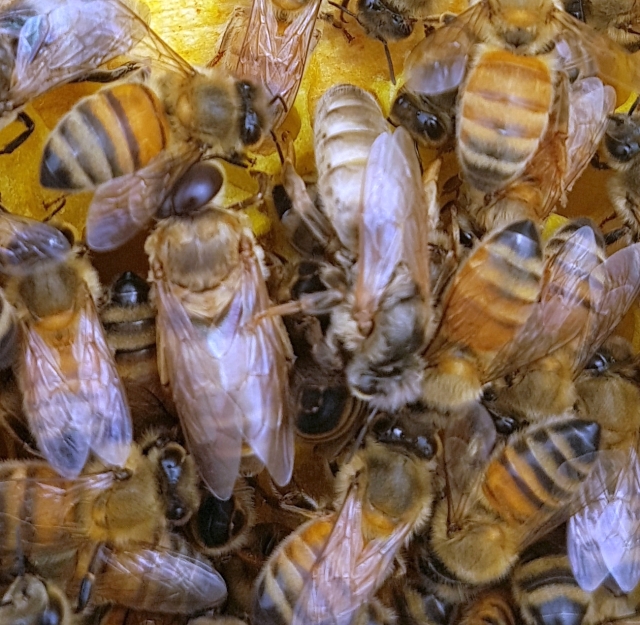
A friend of mine, Jessie, who works the bees at Chinook Honey near Calgary, spotted this unusual queen. Jessie took the pictures on this page. As you can see, the queen has very little colour.
What might cause this apparent lack of pigment? This is not a fuzzy new bee/queen but rather a queen which seems to have been around the block a few times. Yet, I don’t thing she’s hairless in the way a robbing worker or a very old bee might be. Besides, there are some similar drones. Something else is happening here.

A drone, also pictured, would seem to be her brother or son. I think that either is possible, though he’s more likely an offspring. Her male progeny would be a haploid and have genes only from the white queen in the picture.

Has anyone else seen a queen or drone with such lack of colour? Is there a racial subgroup which consistently produces this pale complexion? I have seen perfectly golden ultra-yellow Cordovan queens. Very dark (almost black) Caucasian queens also abound here in western Canada as they tend to winter well. But this is the first whitish queen I’ve seen.
That’s all I know for now. Your thoughts, added below, are welcome.
 .
.

Oddly enough, in this morning’s (6/27/19) Danbury (CT) News Times I read an article about a blonde raccoon.
From that article: “Leucism is a genetic mutation that results in reduced pigmentation in all or part of an animal’s fur, feathers, or scales,” a DEEP official responded to Hill on Facebook. “A leucistic animal is usually all or partially white while retaining some normal colors.”
Leucism is rare, but has been reported in other animals in Connecticut, the official said, but it seems like this might be the first raccoon in the state with this condition.
“Although rare, leucism has been reported in CT in a variety of animals, such as squirrels, turkey vultures, snakes, songbirds, waterfowl, and, in a few occasions, red-tailed hawks — and now a raccoon!” the official wrote. “Very interesting.”
Leucism is not the same as albinism, which is a mutation that prevents pigment or color from being produced
Any connection?
LikeLike
Thanks, that sounds about right! The queen and drone were certainly not ‘albino’ but they fit the description of “usually all or partially white while retaining some normal colors.” The all-knowing Wikipedia says that leucism “is a condition in which there is partial loss of pigmentation in an animal resulting in white, pale, or patchy coloration of the skin, hair, feathers, scales or cuticle, but not the eyes.” This suits the queen bee description, but let’s see if anyone else has an idea.
LikeLike
She certainly looks healthy enough and obviously able to pass on her “special” gene at least part of the time… If leucism is totally a regressive trait, then there must be at least one drone she found that has it as well: )
Will be interesting how she fares! Keep us posted, I hope?
LikeLike
I hope to get more information from Jessie at Chinook Honey. If I do, I’ll keep everyone posted.
Remember that the queen’s unfertilized eggs become drones, so her male offspring would not depend on her meeting similarly mutated suitors.
LikeLiked by 1 person
Yeah sorry bout that… (Obviously I shouldn’t be attempting to write before my brain’s awake; )
LikeLike
Ron, perhaps the pervasive wind borne carryover of Roundup has caused other genetic mutations like a color change that will make some bees suceptible to sunburn as well as less able to fend off mites.
LikeLike
I think that we are all in agreement that a genetic mutation has occurred. It’s not likely due to Roundup as that chemical would have to selectively alter just those genetic loci involved in bee pigmentation. Besides, Roundup isn’t used in the area. But a natural genetic mutation is quite likely. Thanks for your comment.
LikeLike
Is this queen mated and laying eggs?
LikeLike
Hi Medhat,
Thanks for commenting. Jessie says that the photo was taken about 6 or 7 days after the queen emerged, so she’s not laying. Tomorrow the nuc will be inspected. That will be two weeks since the queen cell was introduced so maybe there will be eggs.
Ron
LikeLike
Just curious if anything ever came of this…? I spotted a leucistic worker in my yard today and she was mesmerizing!
LikeLike
Thanks for asking. We had a variety of ideas offered, but no consensus. I was told that the queen was soon superceded.
LikeLike
Pingback: Have you ever seen a queen like this? | How To Start Bee Farming
Pingback: Goodbye, 2019 | Bad Beekeeping Blog
I’ve got a queen in one of my hives that it’s similarly pale with darker black around the end of her abdomen. I call her Blondie. She’s doing well and laying a great pattern. Very happy with her but was worried when she went on her mating flights that she would stand out and get eaten but that didn’t happen.
LikeLiked by 1 person